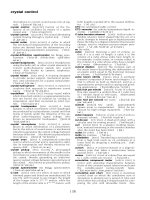Handbook of Lubrication Episode 1 Part 7 pptx
Bạn đang xem bản rút gọn của tài liệu. Xem và tải ngay bản đầy đủ của tài liệu tại đây (2.68 MB, 17 trang )
(9)
The exit construction was first seen experimentally in the circumferential film profile
measured by the X-ray technique.
22
This was followed by optical interferometry.
14,22
While
the measured nominal film shows good correlation with EHLtheories, the measured ratio
of minimum film to nominal film appears to be considerably smaller than 0.7 to 0.75, as
predicted analytically. Film pressure measurements by means of a vapor-deposited manganin
strip confirmed analytical predictions on effect of load on location of the pressure spike.
18,24,25
Film Thickness Chart
Minimum film thickness of EHLline contacts may be determined from the Moes diagram
26
of Figure 7. Film thickness parameter h
min
/R, speed parameter η
o
u/E′R, load parameter,
and lubricant parameter α*E′are regrouped to form an implicit relation among only three
independent parameters. Only one family of curves is needed to relate the film thickness
parameter with the other two parameters over a wide range of loads, speeds, and lubricant
parameters. Martin
1
results are an asymptote for the rigid/isoviscous case, and Herrebrugh
27
for the elastic/isoviscous case.
Point Contacts
Film Thickness
Figure 8 shows a point contact which is characterized by principal radii R
x1
, R
y1
for body
1 and R
x2
, R
y2
for body 2. In general, the principal planes containing R
x1
and R
x2
may not
coincide: however, for most EHLcontacts such as rolling bearings and gears, principal radii
R
x1
and R
x2
do lie in the same plane. These surfaces can be convex, concave, or saddle-
shape, depending on whether R
x
and R
y
are both positive, both negative, or mixed.
Ertel-Grubin type of analysis can also be carried out for spherical contacts with a circular
conjection. Archard and Cowking
28
solved the two-dimensional Reynolds equation outside
the circular conjunction region for a film thickness distribution compatible to the Hertzian
solution for an unlubricated contact. An Ertel-Grubin type boundary condition, q = 1/α,
around the circumference of the circular conjunction gave:
144CRC Handbook of Lubrication
FIGURE 7. Survey diagram for incompressible and isothermal EHL.
Copyright © 1983 CRC Press LLC
Full computer solutions for elliptical contacts were made for flooded as well as for starved
contacts.
30
Film thickness formula for the flooded contacts appear as:
H
c,F
= 2.69 U
0.67
G
0.53
W
–0.067
(1 – 0.61e
–0.73k
) (12)
H
min,F
= 3.63 U
0.68
G
0.49
W
–0.073
(1 – e
–0.68k
) (13)
where H
c,F
= h
c,F
/R
x
, h
c,F
= central film thickness for flooded contacts, H
min,F
= h
min,F
/R
x
,
h
min,F
= minimum film thickness for flooded contacts, k = elliptical parameter, k = 1.03
(R
y
/Rx)0.
64
, R
x
– R
xl
R
x2
/(R
xl
+ R
x2
), R
y
= R
yl
R
y2
/(R
yl
+ R
y2
), W
=
w/ER
2
x
, w = total
load, U = µ
o
(u
1
+ u
2
)/2ER
x
, and G = αE.
For the starved contacts, the formulas are
(14)
(15)
where subscript s refers to starved contacts, m is the distance of the inlet meniscus from
the center of the contact, and m* is the inlet distance required for achieving flooded con-
ditions; m* can be expressed as
(16)
where b is the semiminor axis of the elliptical conjunction in the rolling direction.
In most starvation analyses, location of the inlet meniscus is not known beforehand and
is dependent on lubricant supply rate and system configuration. Reduction in film thickness
due to starvation in most ball bearings is considerably greater than from inlet healing.
31,32
Optical techniques enabled extensive point-contact film thickness measurements and cor-
relations with analysis.
33-36
Film thickness data by X-ray transmission
37
with crowned rollers
showed a much stronger load dependence than that predicted by EHL analysis at maximum
Hertzian pressures beyond 1 GPa (145,000 psi). This disagreement was explained by Gentle
et al.
38
as possibly due to a combination of thermal and surface roughness effects. The point
contact EHL film theory at extreme pressures [up to a maximum Hertzian pressure of 2 GPa
(290,000 psi)l was validated by using a sapphire disk and tungsten carbide ball.
38
Film
thickness measurements using tungsten carbide disks confirm EHL film theories for loads
as high as 2.5 GPa (362,500 psi).
39
146 CRC Handbook of Lubrication
Table 1
VALUES OF C, n
1
, AND n
2
FOR EQUATION 11
a/b C n
1
n
2
5 1.625 0.74 – 0.22
2 1.560 0.736 – 0.209
1 1.415 0.725 – 0.174
0.5 1.145 0.688 – 0.066
Copyright © 1983 CRC Press LLC
Point Contact Film Shape and Pressure Distribution
Film shape in a circular point contact was experimentally revealed by the interferometric
map between a highly polished steel ball and a transparent plate.
23,34,35,36,40
By identifying
successive fringes, constant thickness contours can be mapped. The effect of speed on film
shaped constriction which is very narrow and very close to the trailing edge. As speed
increases or load decreases, the constriction becomes wider and less distinctive. Except for
extremely low loads and high speeds, the minimum film thickness is found at the two sides
rather than at the center of the trailing edge, and it is more sensitive to load variation than
the minimum film thickness for a line contact. Analytical confirmation of the horseshoe-
shaped constriction in a numerical solution of two-dimensional EHLequations
41
with a solid-
like lubricant was followed by a series of full EHLsolutions for circular and elliptical
contacts
30,42
with a Newtonian lubricant.
Temperature
For a line contact, a detailed study of thermal effects required solution of the energy
equation in the lubricant film considering heat generation by shearing and compressing the
lubricant, heat convected away by the lubricant, and heat conducted into the solids.
43,44
Film thickness level is influenced only by temperature rise in the inlet region discussed
earlier; subsequent large temperature rise in the Hertzian conjunction has little influence.
The predicted temperature field within the Hertzian conjunction depends strongly on the
lubricant rheological model used in evaluating the heat generated by sliding. For a Newtonian
model
44
for steel contacts with a maximum Hertzian pressure up to 0.5 GPa, the principal
feature of exit film constriction and pressure peaks are unaltered when thermal effects are
included. However, for loads higher than 0.5 GPa, the Newtonian lubricant model predicts
a sliding frictional coefficient almost an order of magnitude higher than measured. Since
practical sliding EHLcontacts such as gears and cams involve pressures greater than 0.5
GPa, a non-Newtonian lubricant model is needed for the frictional heat. Successful non-
Newtonian models are discussed in the next section.
Early measurement of surface temperature profiles were made with a platinium wire
temperature transducer
24
at moderate loads. Later, an improved transducer
45,46
with a titanium
wire deposited over a silica layer gave good results at much higher loads. While vapor-
deposited probes are yet to perfected, a promising infrared technique was developed by
Nagaraj et al.
47
for measuring the surface as well as film temperature in circular contacts.
Figure 10 shows surface temperature along the center strip of the circular contact. The
measured temperature show good agreement with that predicted from the Jaeger-Archard
48
formula.
Friction
In rolling and sliding EHD contacts, frictional force has two components: one due to
rolling and the other due to slip between the surfaces. Except for nearly pure rolling con-
ditions, sliding friction is always much larger than rolling friction. Basic features of sliding
friction are revealed in Figure 11 by data from a two-disk machine.
49
In the low-slip region,
friction increases linearly with slip. As slip increases, friction gradually tapers off in a
nonlinear region where the stress is no longer governed by linear constitutive relations of
the lubricant. In the high-slip region, friction decreases with slip because of thermal influence
on lubricant properties at high-sliding speeds.
Low-Slip Friction
For low-slip frictions, sliding friction can be predicted from the Maxwell viscoelastic
model. If equilibrium viscosity and shear modulus are used, however, predicted friction is
much greater than measured. This disagreement led to the argument that the viscosity, when
Volume II 147
Copyright © 1983 CRC Press LLC
148 CRC Handbook of Lubrication
FIGURE 9. Effect of load and speed on film shape. (a) W = 10 lb, U = μ
°
u/ER = 3 × 10
−11
; (b) 10 lb, 1.8 × 10
−10
; and (c) 5 lb, 1.5 × 10
−9
.
Copyright © 1983 CRC Press LLC
stress = (1/2τ
ij
τ
ij
)
1/2
, τ
O
= representative stress, a fluid property, η = viscosity, and G =
shear modulus. τ
O
, η, and G are fluid properties deduced from traction tests. Limited values
are given for five oils.
52
Asimilar nonlinear viscous and plastic model introduced recently
by Bair and Winer
58
used rheological constants from tests totally independent of any data
from the EHLcontact itself.
The Bair and Winer
58
model in dimensional form can be written as
(19)
In dimensionless form, it is
(20)
where
Only three primary physical properties are required: low shear stress viscosity, µ
o
, limiting
elastic shear modulus, G
x
, and limiting yield shear stress, τ
L
,all as functions of temperature
and pressure. The behavior of the dimensionless equation is shown in Figure 13. Agreement
between theory and experiment is good.
Volume II 151
FIGURE 12. Nonlinear Maxwell fluid with zero-shear-rate viscosity and infinite-rate shear modulus G. F(τ)
denotes the nonlinear viscous function.
Copyright © 1983 CRC Press LLC
where λ
0.5x
is the correlation length at which the acf of the profile is 50% of the value at
the origin; γmay be interpreted as the length-to-width ratio of a representative asperity
contact. Purely transverse, isotropic, and purely longitudinal roughness patterns have γ =
0,1,∞, respectively. Surfaces with γ> 1 are longitudinally oriented.
For determining partial EHLperformance, surface roughness parameters required for each
surface include: (1) σ— rms surface roughness, (2) height distribution function, (3)λ
0.5x
,
λ
0.5y
— 50% correlation lengths in x and y directions, and (4) acf (autocorrelation function).
Average Film Thickness
Pure longitudinal or transverse roughness was first explored by Johnson et al.
64
for pure
rolling contact based on Christensen’s stochastic theory.
65
They developed a Grubin type
solution for σ
<
<
h and concluded that the effect of roughness on average film thickness is
minimal.
For h/σ> 3and for rolling and sliding contacts, Berthè
66
and Chow and Cheng
67
showed
that:
1. For pure rolling contact with pure transverse roughness, average film thickness is
higher than predicted by smooth surface EHLtheory. This effect is greatly enhanced
as h/σapproaches three. For sliding contacts with one surface smoother than the other,
the roughness effect is enhanced if the smoother surface is faster and retarded if the
smoother surface is slower.
2. For pure longitudinal roughness, average film thickness is lower than predicted by the
smooth surface theory. Superimposing of sliding on rolling has little influence on the
roughness effect for pure longitudinal surfaces.
Patir and Cheng
62
developed an average flow model to handle roughnesses of an arbitrary
surface pattern parameter γand extended the results to h/σbelow three where part of the
load is shared by asperity contacts. Figure 14 depicts the flow pattern for longitudinally
oriented (γ> 1), trasversely oriented (γ< 1), and isotropic roughness (γ = 1). In Figure
15, the ratio of actual film thickness to the smooth surface film thickness is plotted against
film parameters Λ = h
smooth
/σ.
Asperity Load to EHL Load Ratio
Average asperity contact pressure in partial EHL is a function of the ratio of compliance
to composite surface roughness h/σ. Here, compliance is the distance between the two mean
planes based on the underformed surfaces. For Gaussian surfaces, Tallian
59
has derived the
asperity load as a function of h/σ for both plastically or elastically deformed asperities.
The load sharing ratios in circumferential ground EHL contacts (longitudinal roughness)
can be obtained by a full numerical solution for disks with known surface roughness
characteristics.
68
Average Friction
Once the ratio of asperity load to fluid pressure load is determined, total friction force in
partial EHL can be estimated by:
F = µ
a
Q
a
+ µ
EHL
Q
EHL
(22)
where F = total frictional force, µ
a
, µ
EHL
= coefficient of friction for asperity load and
hydrodynamic load, respectively, and Q
a
,Q
EHL
= asperity, hydrodynamic load. For most
partial EHL contacts, µ
a
is believed to be between 0.1 and 0.2. The value of µ
EHL
can be
taken from frictional coefficients for full-film EHL contacts.
Volume II 153
Copyright © 1983 CRC Press LLC
sion, bending of pads, and thermal distortion can significantly affect performance of large,
high-speed thrust bearings.
75,76
Because deformation effects are sensitive to detailed pad
geometry, they can only be determined by elaborate computer codes.
77
APPLICATION TO MACHINE COMPONENTS
Based on EHLtheories, effectiveness of lubrication in rolling element bearings,
3,78-81
gears,
3,78
and cams
82
can be calculated through the film parameter Λ, the ratio of film
thickness to the composite surface roughness. In this section, formulas are taken mostly
from an EHLguide book.
78
Rolling Element Bearings
Roller bearings usually have line contacts and Equation 9 should be used to calculate film
thickness. For ball bearings, contacts are elliptical with semimajor axis normal to the direction
of rolling and Equations 10 through 13 should be used; to evaluate the speed and load
parameter, rolling speed and contact dimensions must be determined from the geometry and
kinematics of the system. Reference 78 gives formulas for all common commercial rolling
bearings. Asimplified film thickness formula, which does not involve detailed bearing
geometry and yet gives an adequate prediction of film thickness, is given below:
78
(23)
where ∧ = h/σ, D = bearing outside diameter, m or in., C = a constant given in Table
2, dimensionless, LP = µ
o
α· 10
11
, sec, µ
o
=
viscosity, N-sec/m
2
or lb-sec/in.
2
, α =
pressure-viscosity coefficient, m
2
/N or in.
2
/lb, N = difference between the inner and outer
race speeds, rpm, h = film thickness in microns if D is in meters or in microinches if D
is in inches, and σ = composite roughness, µm or µin. Typical values of αfor bearings
are given in Table 3.
An adequate ∧for protecting bearing surfaces against early surface fatigue was shown
to be greater than 1.5. Typical values of lubricant parameter, LP, for motor oils can be
found in Figure 16.
156CRC Handbook of Lubrication
Table 2
VALUES OF C
FOR BEARING RACEWAYS
Bearing type Inner race Outer race
Ball 8.65 × 10
−4
9.43 × 10
–4
Spherical and cylindrical 8.37 × 10
–4
8.99 × 10
–4
Tapered and needle 8.01 × 10
−4
8.48 × 10
–4
Table 3
TYPICAL VALUES OF σ
FOR BEARINGS
Composite roughness
Bearing type (µm) (µin.)
Ball 0.178 7
Spherical and cylindrical 0.356 14
Tapered and needle 0.229 9
Copyright © 1983 CRC Press LLC
Note: Where:
⎟⎟ = Absolute (positive) value N
g
= gear wheel speed, rpm T
s
= sun gear torque
C = Center distance N
R
= ring gear speed, rpm T
R
= ring gear torque
E
D
= reduced modulus (equation 2) N
s
= sun gear speed, rpm γ
G
= gear cone angle
F = face width R
Gm
= midface pitch radius γ
P
= pinion cone angle
m
G
= gear ratio R
R
= ring gear radius φ
n
= normal pressure angle
n = Number of planets R
s
= sun gear radius ψ = helix angle
N
c
= Carrier speed, rpm T
G
= gear wheel torque ψ
m
=
midface spiral angle
Table 5
TYPICAL VALUES OF COMPOSITE
ROUGHNESS,
Initial value Run-In value
Tooth finish µm µin. µm µin.
Hobbed 1.78 70 1.02 40
Shaved 1.27 50 1.02 40
Ground soft 0.89 35 — —
Ground hard 0.51 20 — —
Polished 0.18 7 — —
(24)
where G = geometrical parameter from Table 4, LP = µ
o
α
· 10
11
, sec, N = gear rotational
speed, rpm, W
τ
/ᐉ = load per unit length of contact from Table 4, and σ; = composition
roughness, see Table 5.
158 CRC Handbook of Lubrication
Table 4
GEAR EQUATIONS
Copyright © 1983 CRC Press LLC
The critical value of Λat which a 5% probability of surface distress is expected is an
empirical function of pitch line velocity Vas shown in Figure 17. Equations for Vfor
different types of gears are given in Table 4.
Cam-FollowerSystems
The film parameter Λfor a cam-flat follower Figure 18 system can be calculated by
Equation 25:
(25)
Volume II159
FIGURE 17. Adjusted specific film thickness vs. pitch line velocity (5% probability of distress).
FIGURE 18.Geometry of a cam-follower contact.
Copyright © 1983 CRC Press LLC
where N = cam shaft speed, rpm, LP = lubricant parameter, sec, f
N
= |2r
n
– ᐉ|, where ᐉ
is the distance from the nose tip to the shaft axis and r
n
is the nose radius (see Figure 18),
m or in., R = (1/r
n
+ 1/r
f
)
-1
, m or in., r
n
= nose radius, m or in., r
f
= follower radius,
m or in., and σ = composite roughness, µm or µin.
In general, Λ in cam systems is well below one. In this regime, EHL is ineffective and
one must rely heavily on surface film or boundary lubrication to protect surfaces against
scuffing and wear.
REFERENCES
1. Martin, H. M., Lubrication of gear teeth, Engineering (London), 102, 199, 1916.
2. Grubin, A. N., Contact stresses in toothed gears and worm gears, Central Scientific Research Institute for
Technology and Mechanical Engineering, Book No. 30., Moscow. (D S.I R. English Translation No.
337. As communicated by Prof. M. M. Krushchov to Prof. A. Cameron, Grubin’s contribution was originally
studied by A. M. Ertel and after his death was seen ihrough the press by his co-worker Grubin and is thus
often known as Grubin’s name alone.)
3. Dowson, D. and Higginson, G. R., Elastohydrodynamic Lubrication, Pergamon Press, Oxford, 1977.
4. Cheng, H. S., Isothermal EHD theory for the full range of pressure-viscosity coefficient, J. Lubr. Technol.
Trans. ASME, 94(1), 35, 1972.
5. Ford, R. A. J., The Lubrication of High Speed Gas Turbine Roller Bearings, Ph.D. thesis, University of
London, March, 1975.
6. Greenwood, J. and Kanzlarich, J., Inlet shear heating in elastohydrodynamic lubrication, J. Lubr. Tech-
nol. Trans. ASME, 95(4), 417, 1973.
7. Cheng, H. S., Calculation of Elastohydrodynamic Film Thickness in High-Speed Rolling and Sliding Con-
tacts, Rep. No. MTI-67TR24, Mechanical Technology Inc., Latham, N.Y., May 1967.
8. Murch, L. E. and Wilson, W. R. D., A thermal elastohydrodynamic inlet zone analysis, J. Lubr. Technol.,
Trans. ASME, 97(2), 212, 1975.
9. Wolveridge, P. E., Baglin, K. P., and Archard, J. F., The starved lubrication of cylinders in line contact,
Proc. Inst. Mech. Eng., 185, 1159, 1970.
10. Dowson, D., Saman, W. Y., and Toyoda, S., A study of starved elastohydrodynamic line contacts, Proc.
5th Leeds-Lyon Symp. Tribology, Leeds, England, 1979.
11. Archard, J. F., Experimental studies of elastohydrodynamic lubrication, Proc. Inst. Mech. Eng., 180(38),
17, 1965.
12. Crook, A. W., The lubrication of rollers. II. Film thickness with relation to viscosity and speed, R. Soc.
London Philos. Trans. Ser. A, 254, 223, 1961.
13. Sibley, L. B. and Orcutt, F. K., Elastohydrodynamic lubrication of rolling contact surfaces, Am. Soc.
Lubr. Eng. Trans., 4(2), 234, 1961.
14. Wymer, D. G. and Cameron, A., EHD lubrication of a line contact, Proc Inst. Mech. Eng., 188, 221,
1974.
15. Dowson, D. and Higginson, G. R., A numerical solution to the elastohydrodynamic problem, J. Mech.
Eng. Sci., 1(1), 6, 1959.
16. Dowson, D., Higginson, G. R., and Whitaker, A. V., Elastohydrodynamic Lubrication — a survey of
isothermal solutions, J. Mech. Eng. Sci., 4(2), 121, 1962.
17. Archard, G. D., Gair, F. C., and Hirst, W., The elastohydrodynamic lubrication of rollers, Proc. R
Soc. London Ser. A, 262, 51, 1961.
18. Hamilton, G. M. and Moore, S. L., Deformation and pressure in an EHD contact, Proc. R. Soc. London
Ser. A, 322, 313, 1971.
19. Rodkiewicz, C. M. and Srinivanasan, V., EHD lubrication in rolling and sliding contacts, J. Lubr.
Technol. Trans. ASME, 94(4), 324, 1972.
20. Rohde, S. M., A unified treatment of thick and thin film EHD problems by using high order element
methods, Proc. R. Soc. London Ser. A, 343, 315, 1975.
21. Dowson, D., Elastohydrodynamic Lubrication, Interdisciplinary Approach to the Lubrication of Concen-
trated Contacts, Spec. Publ. No. NASA SP-237, National Aeronautics and Space Administration, Wash-
ington, D.C., 1970, 34.
22. Kannel, J. W. et al., A Study of the Influence of Lubricants on High-Speed Rolling-Contact Bearing
Performance, Part IV, Tech. Rep. No. ASD-TR-61-643, Air Force Aero Propulsion Laboratory, Dayton,
Ohio. 1964.
160 CRC Handbook of Lubrication
Copyright © 1983 CRC Press LLC
23. Gohar, R. and Cameron, A., The mapping of F.HD contacts, ASLE Trans., 10, 214, 1967.
24. Orcutt, F. K., Experimental study of elastohydrodynamic lubrication, ASLE Trans., 8, 381, 1965.
25. Kannel, J. W., The measurement of pressure in rolling contacts, Proc. Inst. Mech. Eng., 180(3B), 135,
1965.
26. Moes, I. H., Communications to EHL symposium held at Leeds University, Proc. Inst. Mech. Eng.,
180(3B), 244, 1965.
27. Herrebrugh, K., Solving the incompressible and isothermal problem in elastohydrodynamic lubrication
through an integral equation, J. Lubr. Technol., Trans. ASME, 90(1), 262, 1968.
28. Archard, J. F. and Cowking, E. W., A simplified treatment of elastohydrodynamic lubrication theory
for a point contact, Proc. inst. Mech. Eng., 180(3B), 47, 1965.
29. Cheng, H. S., A numerical solution of the elastohydrodynamic film thickness in an elliptical contact, J.
Lubr. Technol., Trans. ASME, 92(1), 155, 1970.
30. Hamrock, B. J. and Dowson, D., Isothermal elastohydrodynamic lubrication of point contacts, J. Lubr.
Technol., 98(2), 223, 1976; 98(3), 1976; 99(2), 264, 1977; 99(1), 15, 1977.
31. Chiu, Y. P., An analysis and prediction of lubricant film starvation in rolling contact systems, ASLE Trans.,
17, 22, 1974.
32. Chiu, Y. P. et al., Exploratory Analysis of EHD Properties of Lubricants, Rep. No. AL72P10. SKF
Industries, King of Prussia, Pa., 1972.
33. Snidle, R. W. and Archard, J. F., Experimental investigation of elastohydrodynamic lubrication at point
contacts, Proc. 1972 Symp. Elasiohydrodynamic Lubrication, Paper C2/72, Institute of Mechanical Engi-
neers, London, 1972, 5.
34. Wedevan, L. D., Optical Measurements in EHD Rolling-Contact Bearings, Ph.D. thesis. University of
London, March 1970.
35. Westlake, F. J. and Cameron, A., Interferomatric study of point contact lubrication, Proc. 1972 Symp.
Elastohydrodynamic Lubrication, Paper C39/72, Institute of Mechanical Engineers, London, 1972, 153.
36. Sanborn, D. M. and Winer, W. O., Fluid rheological effects in sliding elastohydrodynamic point contacts
with transient loading. I. Film thickness, J. Lubr. Technol., Trans. ASME, 93(2), 262, 1971.
37. Parker, R. J. and Kannel, J. W., EHD Film Thickness Between Rolling Discs with a Synthetic Paraffinic
Oil to 589 K, NASA Tech. Note D-6411, National Aeronautics and Space Administration, Washington,
DC, 1970.
38. Gentle, C. R., Duckworth, R. R., and Cameron, A., EHD Film thickness at extra pressures, J. Lubr.
Technol., Trans. ASME, 97, 383, 1975.
39. Hirst, W. and Moore, A. J., Elastohydrodynamic Lubrication at High Pressures, Tech. Rep., University
of Reading, Reading, U.K., 1977.
40. Foord, C. A. et al., Optical elastohydrodynamics, Proc. Inst. Mech. Eng., 184(1), 487, 1969.
41. Jacobson, B., On the lubrication of heavily loaded spherical surfaces considering surface deformations and
solidification of the lubricant,
Acta Polytechn. Scand. Mech. Eng. Ser., 54, 1970.
42. Ranger, A. P., Numerical Solutions to the EHD Problems, Ph.D. thesis, University of London, March,
1974.
43. Cheng, H. S. and Sternlicht, B., A numerical solution for pressure, temperature and film thickness
between two infinitely long rolling and sliding cylinders under heavy load, J. Basic Eng., Trans. ASME.
87(3), 695, 1965.
44. Dowson, D. and Whittaker, B. A., A numerical procedure for the solution of the elastohydrodynamic
problem of rolling and sliding contacts lubricated by a newtonian fluid, Proc. Inst. Mech. Eng., 180(3B),
57, 1965.
45. Kannel, J. W. and Bell, J. C., A method for estimating of temperature in lubricated rolling-sliding gear
or bearing EHD contacts, Paper C24/72, Proc. 1972 Symp. Elastohydrodynamic Lubrication, Institute of
Mechanical Engineers, London, 1972, 118.
46. Kannel, J. W., Zugaro, F. F., and Dow, T. A., A method for measuring surface temperature between
rolling/sliding steel cylinders, J. Lubr. Technoi. Trans. ASME, 100(1), 100, 1978.
47. Nagaraj, H. S., Sanborn, D. M., and Winer, W. O., Direct surface temperature measurement by infrared
radiation in elastohydrodynamic contacts and the correlation with the Block temperature theory, Wear, 49,
1, 1978.
48. Jaeger, J. C., Moving sources of heat and the temperature at sliding contacts, Proc. R. Soc. N.S.W., 56,
203, 1942.
49. Johnson, K. L. and Cameron, R., Shear behavior of elastohydrodynamic oil film at high rolling contact
pressures, Proc. Inst. Mech. Eng., 182, 307, 1967.
50. Harrison, G. and Trachman, E. G., The role of compressional viscoelasticity in the lubrication of rolling
contacts, J. Lubr. Technol., Trans. ASME, 95, 306, 1972.
51. Dyson, A., Frictional traction and lubricant rheology in elastohydrodynamic lubrication, Philas. Trans. R.
Soc. London, 266, 1170, 1970.
Volume II 161
Copyright © 1983 CRC Press LLC
52. Johnson, K. L. and Tevaariverk, J. L., Shear behavior of EHD oil films, Proc. R. Soc. London, A356,
215, 1977.
53. Barlow, A. J. et al., The effect of pressure on the viscoelastic properties of liquids, R. Soc. London Proc.,
A327, 403, 1972.
54. Montrose, C. J., Moynihan, C. T., and Sasake, H., Dynamic Shear and Structural Viscoelasticity in
EHD Lubrication, Vitreous State Laboratory Tech. Rep., July 1977.
55. Bell, J. C., Lubrication of rolling surfaces by a Ree-Eyring fluid, ASLE Trans., 5, 160, 1962.
56. Trachman, E. and Cheng, H. S., Thermal and non-Newtonian effects on traction in elastohydrodynamic
lubrication, Paper C37/72, Proc. 1972 Syrnp. Elastohydrodynamic Lubrication, Insfitute of Mechanical
Engineers, London, 1972, 142.
57. Smith, F. W., Rolling contact lubrication — the application of elastohydrodynamic theory, J. Lubr.
Technol., Trans. ASME Ser. D, 87, 170, 1965.
58. Bair, S. and Winer, W. O., A theological model for EHD contacts based on primary laboratory data, J.
Lubr. Technol., Trans. ASME, 101(3), 258, 1979.
59. Tallian, T. E., The theory of partial elastohydrodynamic contacts, Wear, 21, 49, 1972.
60. Williamson, J. B. P., Topography of solid surfaces, in Interdisciplinary Approach to Friction and Wear,
NASA SP-181. National Aeronautics and Space Administration, Washington, D.C., 1968, 143.
61. Whitehouse, D. J. and Archard, J. F., The properties of random surfaces of significance in their contact,
Proc. R. Soc. London, A316, 97, 1970.
62. Patir, N. and Cheng, H. S., An average flow model for determining effects of three dimensional roughness
on partial hydrodynamic lubrication, J. Lubr. Technol., Trans. of ASME, 100(1), 12, 1978.
63. Feblenik, J., New developments in surface characterization and measurement by means of random process
analysis, Proc. Inst. Mech. Eng., 182(3K), 108. 1967.
64. Johnson, K. L., Greenwood, J. A., and Poon, S. Y., A simple theory of asperity contact in elastohy-
drodynamic lubrication, Wear, 19, 1972, 91.
65. Christensen, H., Stochastic models for hydrodynamic lubrication of rough surfaces, Proc. Inst. Mech.
Eng. Tribology Group, 184(1,55), 1013, 1969.
66. Berthè, D., Les Effects Hydrodynamiques Sur La Fatigue Des Surfaces Dans Les Contacts Hertziens,D.
Sc. thesis, University of Lyon, France, 1974.
67. Chow, L. S. H. and Cheng, H. S., The effect of surface roughness on the average film thickness between
lubricated rollers, J. Lubr. Technol., Trans. ASME, 98(1), 117, 1976.
68. Cheng, H. S. and Dyson, A., Elastohydrodynamic lubrication of circumferentially ground disks, ASLE
Trans., 21(1), 25, 1978.
69. Cheng, H. S., On some aspects of micro-elastohydrodynamic lubrication, Proc. 4th Leeds-Lyon Symp.
Lubr., April 1977.
70.
Christensen, H., Elastohydrodynamic theory of spherical bodies in normal approach motion, J. Lubr.
Tech., Trans. ASME, 92, 145, 1970.
71. Lee, K. M. and Cheng, H. S., The Effect of Surface Asperity on the Elastohydrodynamic Lubrication,
NASA CR-2195, National Aeronautics and Space Administration, Washington, D.C., 1973.
72. Fowles, P. E., The application of elaslohydrodynamic theory to individual asperity-asperity collisions, J.
Lubr. Tech., Trans. ASME, 91, 464, 1969.
73. Fowles, P. E., A thermal elastohydrodynamic theory for individual asperity-asperity collision, J. Lubr.
Tech., Trans. ASME, 93, 383, 1971.
74. Rohde, S., Thick film and transient elastohydrodynamic lubrication problems, Proceedings on Fundamen-
tals of Tribology. MIT Press, Cambridge, Mass., 1979.
75. Castelli, V. and Malanowski, S. B., Method for solution of lubrication problems with temperature and
elasticity effects: Application to sector, tilting-pad bearings, J. Lubr. Technol. Trans. ASME, 91(4), 634,
1969.
76. Taniguichi, S. and Ettles, C., A thermal elastic analysis of the parallel surface thrust washer, ASCE
Trans., 18(4), 299, 1975.
77. Ettles, C., The development of a generalized computer analysis for sector shaped tilting pad thrust bearings,
ASLE Trans., 19(2), 153, 1976.
78. Anon., EHL Guidebook, Mobile Oil Corporation. New York, 1979.
79. McGrew, J. M. et al., Elastohydrodynamic Lubrication — Preliminary Design Manual, Tech. Rep.
AFAPL-TR-70-27, Air Force Propulsion Laboratory, Dayton, Ohio, 1970.
80. Cheng, H. S., Application of Elastohydrodynamics of Rolling Element Bearings, ASME Paper 74-DE-32,
American Society of Mechanical Engineers, New York, 1974.
81. Anon., SKE Engineering Data, SKF Industries, Inc., King of Prussia, Pa., 1968.
82. Dyson, A., Discussion of “Elastohydrodynamic Lubrication” by D. Dowson, Spec. Publ. SP-237, National
Aeronautics and Space Administration, Washington, D.C., 1970.
83. Orcutt, F. K. and Cheng, H. S., Lubrication of rolling contact instrument bearings, gyro spin-axis,
Hydrodynamic Bearing Symp., Vol. 2, M.I.T. Instrument Laboratory, Cambridge, Mass., 1966.
162 CRC Handbook of Lubrication
Copyright © 1983 CRC Press LLC
METALLIC WEAR
F. T. Harwell
INTRODUCTION
Nature of Wear
Wear of material from machine elements may occur as the result of direct overstressing
of surface material, by fatigue of subsurface material, melting, evaporation, chemical attack,
or by electrical or electrolytic action. Because various mechanisms may act either singly or
in combination, the rate of wear may sometimes be determined by competition and sometimes
by mutual reinforcement of two or more effects. There are, therefore, no simple laws to
enable wear rates to be calculated without reference to specific environmental and operational
conditions relating to the actual machine under consideration. For example, the expression
γ = kWV/H (1)
where γ is the wear rate, W the applied load, V the sliding speed, and H the hardness of
the material is only applicable over a very limited range of variables.
28
Lubrication is essential in most machines to reduce friction and the rate of wear to tolerable
values. This introductory section will, however, concentrate on the wear of metal without
deliberate lubrication.
Conformal and Counterformal Surfaces
The most important consideration governing tribological interaction of two solid objects
is their shape, because this determines both the nature of the stress system and the thermal
regime. Two broad categories are as follows:
1. Conformal surfaces wherein stress is distributed over a comparatively wide nominal
area.
2. Counterformal surfaces which produce either “point” or “line” contact. The surfaces
deform either elastically or plastically so as to provide an adequate area of contact.
56
Compressive stress at the surface of such a Hertzian contact is distributed in accordance
with a parabolic law with the highest stress being at the center. Shear stress in the
absence of tangential loading reaches a maximum at a depth within the surface of
about l/6th of the breadth of the contact zone. While detailed methods enable cal-
culating the stresses in bodies of various shapes,
4,12,56
the following simple cases will
enable the nature of Hertzian stress to be appreciated.
Spheres in Contact
Radius of circle of contact = a
(2)
where W = load, v
1
and v
2
=
Poisson’s ratio of material of spheres 1 and 2, respectively,
E
1
and E
2
=
Young’s modulus of elasticity of spheres 1 and 2, respectively, and r
1
and r
2
= radii of spheres.
When both spheres are made from material having the same modulus of elasticity and
when Poisson’s ratio equals 0.3,
Volume II 163
163-184 4/10/06 12:36 PM Page 163
Copyright © 1983 CRC Press LLC
(4)
where p
o
, the maximum compressive stress, is 2/3 times the average value. The maximum
shearing stress is approximately at a depth of 1/2 a below the surface. The maximum tensile
stress occurs at the edge of the contact zone. Its magnitude is given by
(5)
Parallel Cylinders in Contact
Breadth of contact strip = 2a
(6)
where P is load per unit length of the cylinders in contact,
(7)
Maximum shearing stress is 0.304 p
o
and occurs at a depth of 0.78a below the surface.
The elastic limit is reached when p
o
= 1.7 × the yield strength in compression.
5
The fact that maximum shear stress is situated, a definite distance within the interacting
bodies causes crack formation to occur by fatigue action on an internal plane. Eventually,
cracks will join this plane to the surface giving rise to “pitting”-type failure.
Temperature of Interacting Surfaces
The amount of heat liberated at contact will be determined by the product of the force
acting between the surfaces, the velocity of relative motion, and the coefficient of friction.
The temperature of the contact will depend on the thermal diffusivity of the material and
the rate of supply of fresh material into the contact zone. A good estimate of the “flash
temperature”, that is the excess of temperature caused by friction over the bulk temperature
of the machine elements, is given by Blok
7
as
(8)
where P is the load per unit width (measured at right angles to direction of relative motion),
2a is the width at the Hertzian contact band (measured in direction of relative motion), U
1
and U
2
are the surface velocities, K
1
and K
2
are the thermal conductivities, ρ
1
and ρ
2
are
the densities, and c
1
and c
2
are specific heats per unit mass relating to the two bodies. An
appropriate value for µ, the coefficient of friction, may vary widely from about 0.15 to 1
according to the effectiveness of any lubrication or any surface films. Oxygen or water
vapor, for example, may cause films to be generated, which either mitigate the effects of
metal-to-metal contact or have harmful abrasive effects.
CHARACTERISTIC MODES OF DAMAGE
Terminology
For the purpose of this handbook, wear will be divided into the following categories:
164 CRC Handbook of Lubrication
(3)
163-184 4/10/06 12:36 PM Page 164
Copyright © 1983 CRC Press LLC
smooth sliding (mild), severe, adhesive, fatigue, fretting, impact, gouging, firecracking,
corrosion, cavitation, and electrical effects.
When two ferrous materials are rubbed together under moderate load, a certain degree of
protection may be offered by the generation of oxide films and the sliding will occur smoothly
and without gross damage. This has been described as “mild wear” but the writer proposes
the substitution of “smooth sliding” because the rate of wear can in certain circumstances
be greater during “mild” than during “severe” conditions.
Transition Between “Smooth Sliding” and “Severe” Wear
The transition between different modes of wear may be abrupt and may be reversed even
when the severity of the applied conditions is apparently increased. The complexity of the
interaction is illustrated by two classical experiments.
Kerridge
22
loaded a flat-ended pin of tool steel against the peripheral surface of a rotating
ring within an enclosure which could be evacuated. The pin was made radioactive and was
softer than the ring, the hardness values being 270 and 860 HD
30
, respectively. Material
was rapidly transferred from the pin to the ring which soon attained a constant value of
radioactivity and the wear rate was constant throughout the test. When the radioactive pin
was replaced by an inactive pin the activity of the ring soon ceased. These results showed
that metal was first transferred from the soft pin to the harder ring. This metal rapidly formed
an oxide film which resisted further transfer and thus introduced a “rate limiting” action.
As this oxide was gradually removed by rubbing or fatigue, further transfer of material could
take place at a controlled rate.
Kragelskii
26
found that during some experiments on the sliding of Armco iron, the wear
rate fell off by a factor of about 600 when the rate of sliding increased beyond a certain
value. When the interfacial region was cooled by liquid nitrogen there was a very high-wear
rate. When it was electrically heated, wear was reduced one-thousand fold. Kragelskii
explains the contrasting behavior by a hardness or strength gradient within the material.
When the interface between rubbing surfaces is composed of weak material, sliding will
take place there with relatively little damage; when the bond between the surfaces is stronger
than the underlying layers, failure will occur within the bulk of the material causing con-
siderable roughening and superficial damage.
There are, therefore, two fundamentally different ways in which rubbing surfaces may
react. During “external” friction, contact between the surfaces is dispersed and the true
area of interaction depends on the applied load and the strength properties of the weaker
material. With “internal” friction the surface of action is continuous, is independent of load
and the zone undergoing deformation occupies a considerable volume.
Effect of Environment
Clarification of the effect of environment is provided by Soda and Sasada
50
who studied
the wear of pure metals in air under pressure ranging from 10
–6
to 760 torr. For most metal
combinations the wear was “cohesive”, but for the transition metals (Ni, Fe, Pt, Mo, and
W) “noncohesive” wear occurred except under high loads (Figure 1).
This transition was explained by the “mean free time” of a contact point. Asmall surface
of bare metal would be formed every time a contact bridge was broken. Gas molecules
would attack the clean spot forming a chemisorbed layer which would be thereby protected
from welding. When either the speed or the load was high, the time between events would
be too short for an effective protective layer to form and severe or cohesive wear would
occur. When air is replaced by nitrogen, Sasada and Kando
43
showed that the mean size of
particles was increased by over one hundred times. The powerful effect of oxygen prevented
surface adhesion and subsequent particle growth.
Figure 2 shows the variation of wear rate with speed for Ni on Ni in air and vacuum.
Volume II 165
163-184 4/10/06 12:36 PM Page 165
Copyright © 1983 CRC Press LLC
a
Ultimate tensile strength.
From Clayton, P., in Tribology 1978 Materials Performance and Conservation, Institute of Mechanical Engineers
Conference Publication, Swansea, 1978, 83. With permission.
provide an example of the reaction of steel to intense Hertzian stresses. Clayton
9
describes
a type of wear where intermittent high-stress dry-rubbing contact induces severe surface
deformation which leads to the formation of small deformed metal wear platelets.
Table 1 shows the relative wear resistance of different steels under operating conditions.
Laboratory tests produced results which were consistent with track observations and Clayton
concluded that the wear-rate was a function of cumulative plastic strain ⑀. If the equation
for a monotonic stress-strain curve is given by
σ = K(⑀)
n
(9)
where K and n are constants, then plastic strain is given by
(10)
Hence, wear rate is a function of
He considers that wear is more likely to be stress-related than strain controlled and produces
the
(11)
For Hadfields steel with K taken as 2800 N/mm
2
and n as 0.31, a wear rate of 0.0332 mm
3
/
cm is predicted which corresponds to the relative value obtained.
Jamieson
18
investigated mechanical wear of wheels and rails due to negotiation of curves.
Two mechanisms differed in the rate of metal loss by factors of 10 to 100. Low-rate “flow-
Volume II 167
Table 1
RELATIVE WEAR RESISTANCE OF RAIL STEELS IN CURVED TRACK
163-184 4/10/06 12:36 PM Page 167
Copyright © 1983 CRC Press LLC









